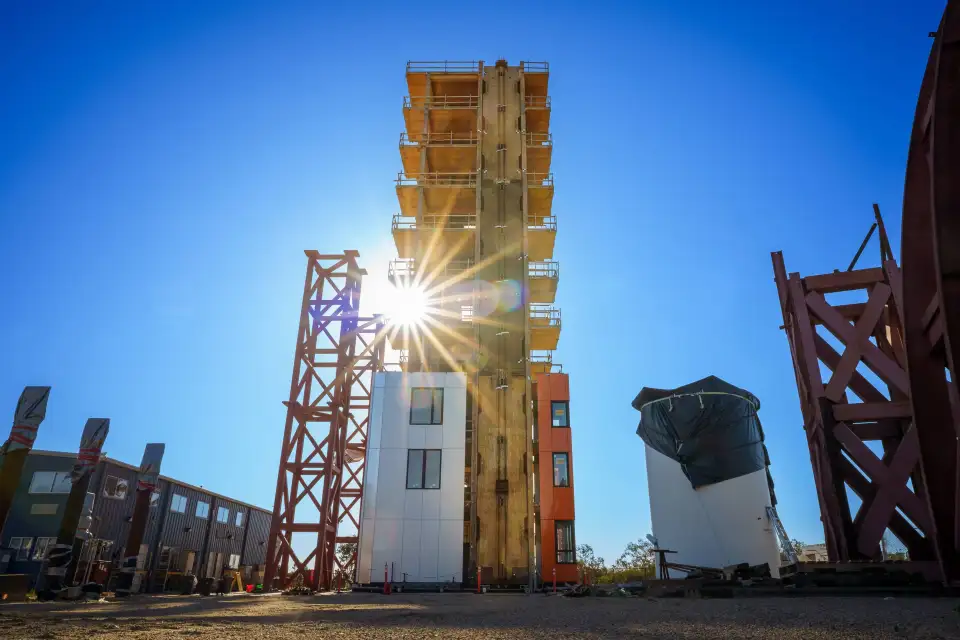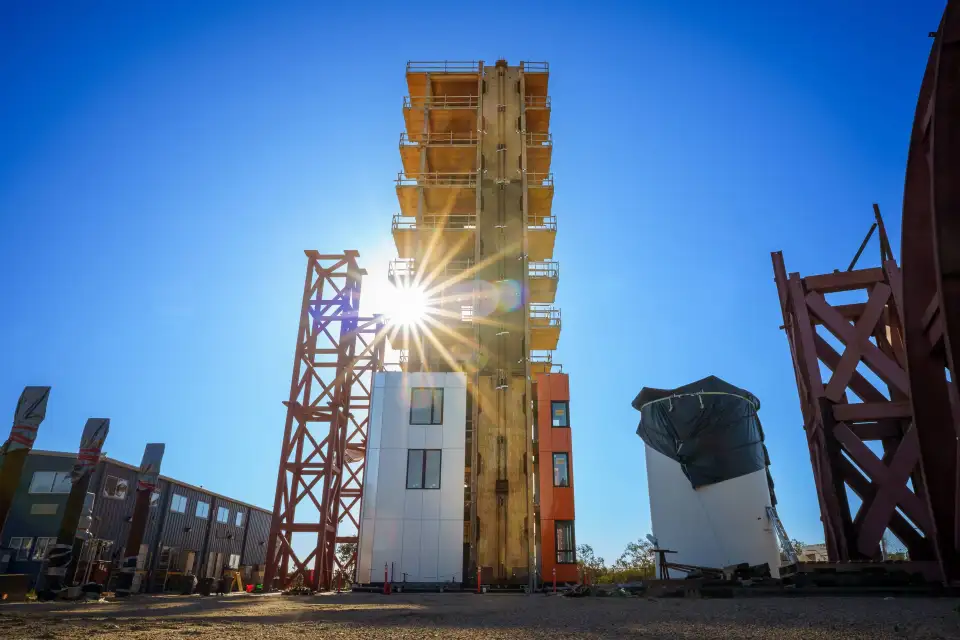
A 10-story mass timber building project sailed through a whole lot of shaking in a seismic resilience research effort that was conducted on the world’s largest outdoor shake table at the Englekirk Structural Engineering Center at the University of California San Diego (UC San Diego). Conducted between May 1 and May 22, 2023, the research represents just the first phase of testing on the Natural Hazards Engineering Research Infrastructure (NHERI) TallWood project, which simulated the equivalent of approximately 10,000 years-worth of seismic activity based on models of seismic activity for the Seattle area. Preliminary results reveal that mass timber structures like TallWood—which has been constructed with a combination of cross laminated timber (CLT) and other high-performance mass timber components—can withstand the forces involved in even extreme seismic testing.
“Shake tables are very important for this purpose,” says Koorosh Lotfizadeh, the operations manager for the Englekirk Structural Engineering Center shake table (known formally as the UC San Diego Large High-Performance Outdoor Shake Table [LHPOST6]). “To verify new building technologies like mass timber, you need to make sure it’s safe for an earthquake, and the only real way to do that is to shake it and see what happens to validate your models.”
After approximately 100 individual tests, including four simulated earthquakes that achieved shaking intensities up to 7.7 on the Richter scale and predicted to occur on average once every 2,500 years, the building remains not just plumb, but with only cosmetic, non-structural damage. This damage appears to have occurred primarily when shakes exceeded design levels, and includes only minor cracks in drywall and connectors. The team observed no structural damage or safety concerns, including the stairs system, which served as the access point for each of the ten floors. In fact, the glass in the windows didn’t even crack. This is especially impressive given the fact that the shake table accelerated to produce forces of at least 1g and produced forces of up to 2gs at the top of the building, which is similar to what astronauts endure during liftoff.
Producing this amount of power is no small feat, and the closed-loop hydraulic system housed beneath the 25- by 40-foot steel platform on which the close to 600,000-pound TallWood stands is truly gargantuan. Dr. Lotfizadeh describes LHPOST6 as an engineers’ playground, though anyone who grew up playing a lot of original Nintendo might have flashbacks to the seventh world of Super Mario Bros. 3 (i.e., Pipe Land).


While conceptualizing the size of the system may be difficult, Dr. Lotfizadeh summed up the amount of power it can produce with the following analogy: The Northridge earthquake in 1994 reached a magnitude 6.7 on the Richter scale and generated just over 1g of horizonal and vertical accelerations. It also caused 57 deaths and cost $20 billion in damage and $49 billion in economic loss—the equivalent of $41 billion and $101 billion in 2023 dollars, respectively. By comparison, the rate of acceleration the actuators at the LHPOST6 can achieve is artificially capped at 3.8g. Lotfizadeh notes that this limitation is not due to the hydraulic system’s capacity; rather, the team thinks that increasing the actuators’ rate of acceleration beyond this point could produce forces that literally tear the facility apart, especially when combined with the enormous mass of the system and whatever sits atop the shake table (which has the capacity to carry a 4,500,000-pound payload).
“This building is only 13% of our payload capacity,” Lotfizadeh says of TallWood.
Despite being only a fraction of what the facility can handle, TallWood is the tallest building of any kind to be tested on a shake table at full scale, according to the principal investigator on the project, Shiling Pei, P.E., Associate Professor in the Department of Civil and Environmental Engineering at the Colorado School of Mines, and it took approximately eight months to construct. It was not only because of its height but because it contains multiple non-structural components, including a variety of facades, windows, doors, and even drywall that all had to be installed before testing could commence.
These were torturously idle months for many of the scientists at the facility, since the TallWood program was the first major experiment to use the shake table since being upgraded between 2019 and 2022. When it was built approximately 20 years ago, LHPOST6 could only replicate seismic events using a single degree-of-freedom. Following the upgrades, it can now replicate aspects of seismic activity in three dimensions and with six degrees-of-freedom, meaning “it can go in the longitudinal direction; it can go in the lateral direction; it can go up and down; and it can rotate in all directions (roll, pitch, and yaw),” according to Lotfizadeh.
More than just reproducing virtually any seismic event within greater fidelity, these upgrades have improved predictive modeling. Going forward, this will allow engineers to make improvements to design codes and better validate the structural integrity of new materials—like mass timber. Therefore, having the TallWood project be the first major experiment to take place at the facility since the upgrade seems fitting.
Those involved with the project believe the tests could have major implications for the architectural, engineering, and construction industry, and lead to changes in building codes in areas with significant seismic activity. Currently, the International Building Code puts height restrictions on mass timber structures of 18, 12, and 6 stories depending on construction type, though these restriction have not been universally adopted by all states and jurisdictions. Proof that mass timber buildings can withstand seismic events above the design level could lead to code changes and potentially accelerate the adoption of mass timber in largescale residential and commercial buildings.

“This project allows us to dig deep and educate ourselves on how our solutions perform with adjacent systems in an earthquake and in the most realistic settings possible, outside of actual disaster events,” says Kevin Smith, P.E., CWI, Senior Engineering Manager at Construction Specialties, one of the industry partners involved in the study. Construction Specialties outfitted TallWood with their DriftReadyTM Stairs system. “The ultimate goal is to improve the resilience of the building itself and the components that are critical to life safety,” Smith adds.
Funding for the project came primarily from the National Science Foundation and US Forest Service, while the majority of the mass timber that makes up TallWood was donated by the project’s industry partners. The construction and pre-fabrication of the columns, beams, and the deck for the top four levels of the structure were completed by Timberlab, an affiliate company of Swinerton, while TallWood itself was designed by the TallWood research team in collaboration with industry partners including KPFF Consulting Engineers and LEVER Architecture. Leading research teams involved include faculty and graduate students from the Colorado School of Mines; the University of Washington; the University of Nevada, Reno; Colorado State University; Washington State University; and University of California San Diego. Industry partners include Simpson Strong-Tie, Sumitomo Forestry, and Boise Cascade, among others.
The testing at LHPOST6 is just one facet of the TallWood project, which is a multistage and industry-wide effort to validate new mass timber tall building archetypes that can respond resiliently to major seismic events. As of August 2023, researchers began the arduous task of disassembling TallWood, the pieces of which will be sent out for further analysis and potential reuse. A more comprehensive review of TallWood’s performance is expected to be published later in the next a few months.
